Comparison of Infrared detectors for GPC/SEC analysis
- January, 19 2021
- Category: GPC/SEC
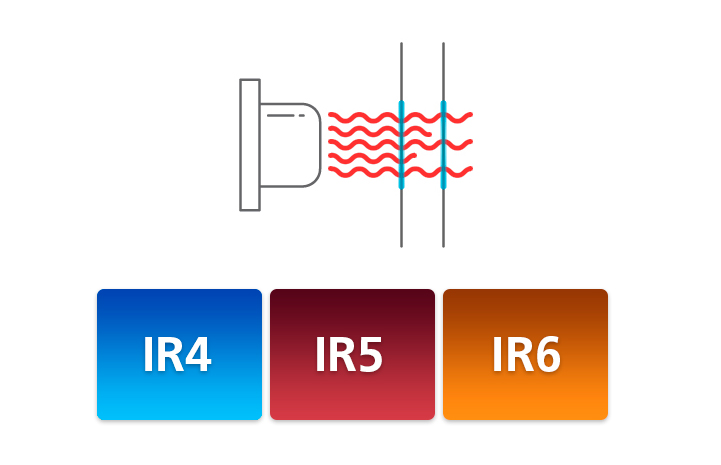
By coupling GPC-IR and GPC-QC* with any of Polymer Char’s Infrared detectors – IR4, IR5, or IR6 – it is possible to obtain both molecular weight distribution and chemical composition information of polyolefin resins.
Each IR detector was developed with a specific application in mind, and their capabilities vary from one another. The purpose of this guide is to help you choose the Infrared detector most suited to your polyolefin characterization needs.
IR4 Detector
IR4 is a dual-wavelength detector, which uses the principle of infrared absorption spectroscopy to measure the concentration and chemical composition in polyolefins.
Besides the default concentration sensor, the IR4 detector also includes a methyl sensor for the determination of ethylene content.
IR4 was the first Infrared detector developed by Polymer Char, and is the entry-level option for all the company’s portfolio of equipment. The sensitivity of the IR4 is lower than that of the IR5 and IR6 detectors. However, it deserves to be considered as an introductory step in the combination of GPC coupled to IR detection, providing the user with a good idea of how the comonomer is incorporated along the Molecular Weight Distribution in polyolefins.
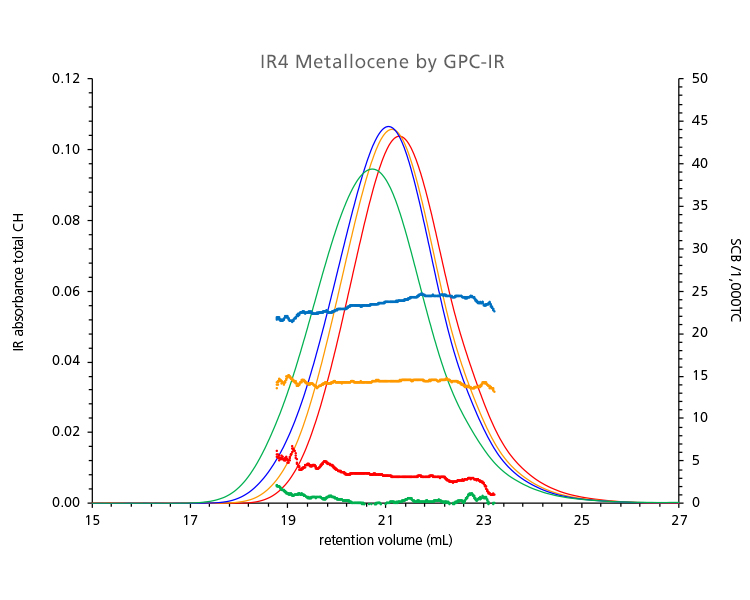
Molecular Weight Distribution with Short Chain Branching content of 4 metallocene resins analyzed by GPC-IR with IR4.
IR5 Detector
IR5 was developed especially for measuring the chemical composition in pipe resins, typically HDPE. The main characteristic of these resins is their low number of short chain branches; therefore, a high sensitivity detector is needed to distinguish and properly characterize them.
The IR5 detector incorporates interference filters at five different wavelengths, and a high sensitivity thermoelectrically cooled MCT sensor with no requirements of liquid nitrogen.
It delivers an outstanding baseline and sensitivity both in concentration and also in short chain branching, as it is capable of detecting approximately 1 SCB/1000TC.
IR5 is 10 times more sensitive than IR4, which means that the user can inject 10 times less concentration and still get a good signal. This makes the IR5 detector the ideal option for the GPC/SEC analysis of polyolefins, where sometimes sample concentration must be reduced for practical reasons (e.g. to avoid obstructions), or small differences in composition must be detected for ensuring a proper microstructural characterization.
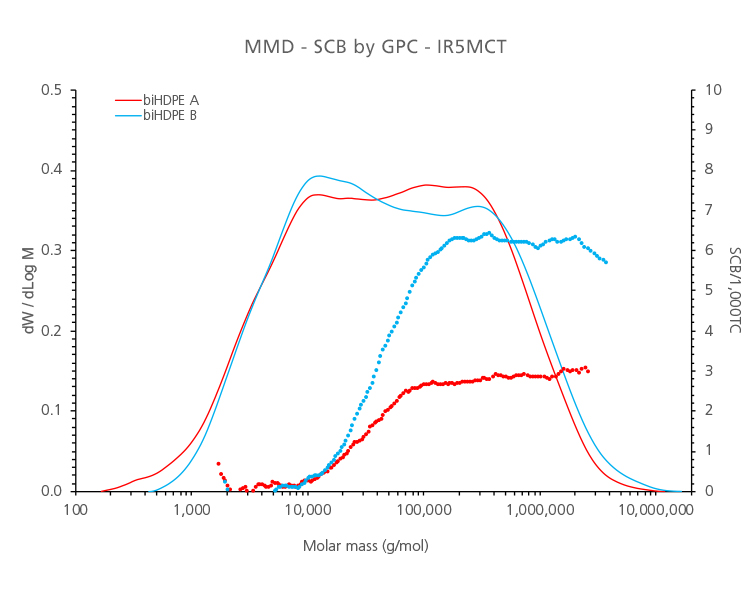
Molecular Weight Distribution with Short Chain Branching content of 2 different bimodal HDPE resins analyzed by GPC-IR with IR5.
IR6 Detector
IR6 is Polymer Char’s latest development in Infrared detection.
As well as having the same features and high-sensitivity as the IR5 detector, IR6 is also able to measure the carbonyl group in the 1,740 cm-1 band.
The IR6 detector is recommended for users who want to analyze a broader range of applications without compromising on stability or sensitivity. The polymers that can be analyzed by IR6 include Ethylene Vinyl Acetate (EVA), Ethylene butyl acrylate (EBA), polyesters, Polylactic acid, MAH-grafted polyolefins, additives, degradation studies, and others within the carbonyl group present in the aforementioned IR band.
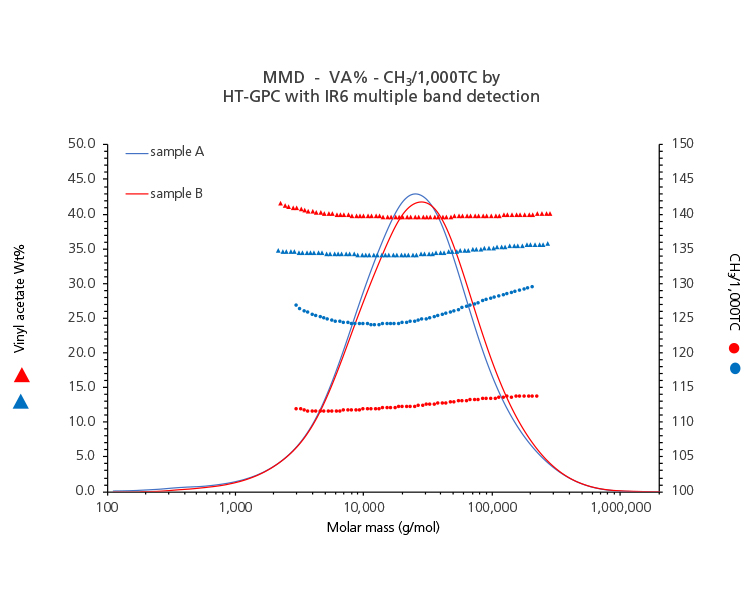
Molecular Weight Distribution with VA content and SCB content of 2 different samples analyzed by GPC-IR with IR6 detector.
Summary
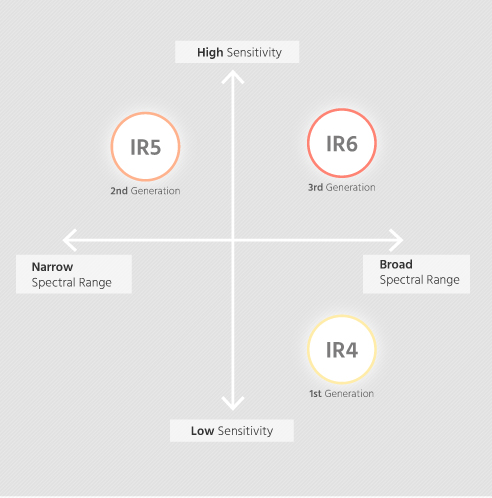
According to the type of samples and sensitivity needed, we should be able to make our choice of IR detector by following this summary table:
| Samples | Results | Comments | |
|---|---|---|---|
| IR4 | All Polyolefins | Concentration, low resolution Composition (SCB) | Entry-level Option |
| IR5 | All Polyolefins, even those with low level of SCB such as HDPE resins | High Sensitivity Concentration, Composition (SCB) | High Sensitivity Recommended Option |
| IR6 | All Polyolefins, even those with low level of SCB such as HDPE resins and also EVA, EBA… or others with C=O group. | High Sensitivity Concentration, Composition (SCB) and carbonyl groups detection | High Sensitivity Recommended for samples with C=O groups |
As a summary, an IR detector has become a must in Gel Permeation Chromatography for polyolefins, because it allows the much-needed deeper microstructural characterization thanks to the short chain branching information it provides. It will also help the user in the day-to-day tasks of this demanding technique in polyolefins, thanks to its relevant advantages in the experimental side due to its stability and calculations simplicity.
The technology used in Polymer Char’s infrared detection is patented.
*GPC-QC is only available with the IR4 and IR5 detectors.